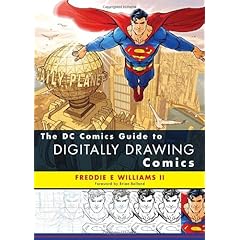 My art library is relatively small, but steadily growing. I have found that the books I end up with tend to fall into one of two categories: inspirational and instructional.
My art library is relatively small, but steadily growing. I have found that the books I end up with tend to fall into one of two categories: inspirational and instructional.The inspirational books are primarily collections of art work, though some 'how to' books will fall under this category if I'm kinda into the art, but don't really get anything new or worthwhile from the text. Usually, I'll look through them, taking a mental inventory of what kind of art is to be found, and set them aside until I need a specific type of inspiration. They cover a variety of artistic styles and subject matter, and are themselves subjective to the kind of inspiration they provide.
Lately, though, what I've tried to focus on getting are books of a more technical or instructional nature - titles such as: Scott McCloud's Making Comics, James Gurney's Imaginative Realism, Vol. 1 of the Best of Wizard's How to Draw series, and pretty much anything by Andrew Loomis.
These books go in depth with the processes and methodology of artists I respect and admire. I am happy to add to this list The DC Comics Guide to Digitally Drawing Comics, by Freddie Williams II.
I should make clear, though, that it's not Mr. Williams' style I am such a fan of - despite his obvious ability and DC's stamp of approval. What intrigues me most about his work is his process, and that is the main focus of this book. FWII (if I may be so bold . . . and lazy) does his work entirely in Photoshop.
His process basically breaks down into the following steps:
- Load the script for a page and make very rough gestureal sketches for each panel beside the descriptions.
- Move/resize the roughs into panels and develop them further on a new layer.
- Make thin 'wireframe' inks for each panel - sans any sort of lighting or texture. Strictly structural and provides a groundwork for inking.
- Make outlines (contours) of the foreground elements in each panel.
- Turn the contours into "cardboard cutouts" that can be repositioned as needed, but block background elements.
- Ink and drop in black areas.
Another section I found fascinating (simply because I'd never thought of it before) was on making paths of complex background elements, such as building facades and chest emblems, which could then be stored, reused, and distorted to meet the artists' needs. FWII also makes use of Google Sketchup to build entire cityscapes for his scenes. Since I like playing around with Sketchup, I found this to be a pretty cool idea.
On the downside, if you are at all familiar with Photoshop, at least one or two chapters of the book will be going over the same information about the program that this topic always seems obligated to address. Also, there was some background information about the author and the evolution of his process that was mildly interesting, but certainly not what I was after when I decided to get the book.
Overall, I am very happy I got this book, having devoured it in its entirety in less than half the time it took for my laptop to upgrade Windows 7. I would recommend it to anyone interested in producing comic-style artwork and looking to make at least some part of the process digital.
One last tidbit: I have read, to some extent or other, all of the "DC Comics Guide to" series, and this is the first one I felt compelled to buy.
No comments:
Post a Comment